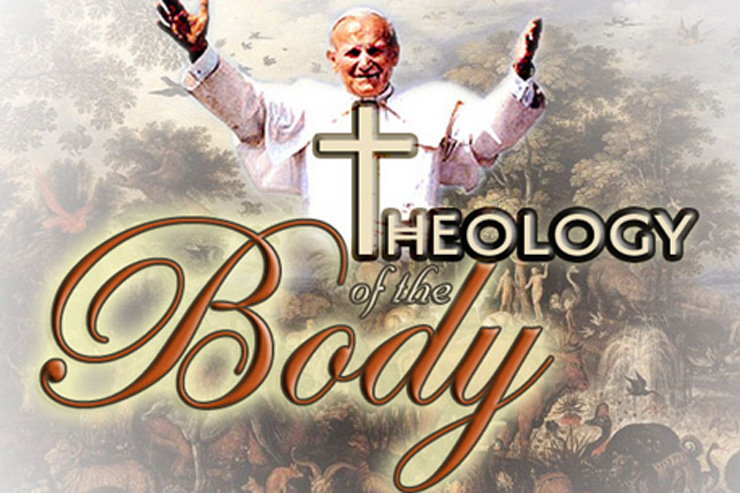
Editor’s Note: This is the first in a series of articles written by Dr. Edward Sri on Saint John Paul II’s Love and Responsibility. The series is reprinted here with permission and originally appeared in the January/February 2005 issue of Lay Witness magazine. © 2005 Catholics United for the Faith / www.cuf.org/Laywitness/index.asp
In his book Love and Responsibility, Karl Wojtyla—now known as John Paul II—reflects not simply on why contraception is immoral, but even more, on how contraception actually can destroy the love between a husband and wife in marriage. Here, we will consider four points from his reflections on this topic.
‘What can a celibate priest really teach us about love, sexuality, and relationships between men and women?’
That’s the question a Polish priest, Fr. Karol Wojtyla, addressed in the introduction to his revolutionary book, Love and Responsibility. Published in 1960, this book on sexual ethics was the fruit of Fr. Wojtyla’s extensive pastoral work with young people and his philosophical reflections on this topic while serving as a priest and university professor in Krakow—long before the world would come to know him as Pope John Paul II.
In Love and Responsibility, Fr. Wojtyla argues that while a priest may lack direct experience in marriage and sexuality, he has something that gives him an even wider perspective on these matters: a broad “secondhand experience.” As a spiritual advisor who worked closely with many young adults and married couples amidst their struggles in love and sexuality, Fr. Wojtyla was able to draw from the experiences of a wide range of personalities, relationships, and marriages in a way that the average layman could not. Love and Responsibility is the fruit of this rich pastoral experience as well as his own philosophical and theological reflection on love, sex, and marriage.
A “Great Book”
Janet Smith, one of the leading teachers in America on Catholic sexual ethics, argues that Love and Responsibility is not just an important book, but that it should be recognized as one of the greatest works of Western Civilization. Right up there with Homer’s Iliad, Dante’s Divine Comedy, and Augustine’sConfessions, we should expect to find Pope John Paul II’s Love and Responsibility on the list of the great books read around the world for centuries to come. She says, “I maintain that the Pope’s book belongs in this group, since I think generations to come will read his book—they certainly should do so, for if they do they will find that it boldly confronts questions we all have about life and offers a way of viewing human relationships which, if accepted, would radically alter the way in which we conduct our lives.” [1]
Indeed, Love and Responsibility provides insights on male-female relationships that are truly life-transforming—and desperately needed today. Growing up in the aftermath of the sexual revolution, the younger generation is hungering for any wise guidance they can get on how to navigate their relationships with the opposite sex. Single people, engaged couples, and married spouses alike will find in Love and Responsibility not only a very different perspective from what the world tends to offer, but a view that, once encountered, cannot help but have a positive impact on the way we relate to one another.
In this short series of articles, my goals are modest. I do not intend to offer an academic analysis of this book or enter scholarly debate about sexual ethics. Rather, I simply aim at making some of the insights from this challenging philosophical work more accessible to the average lay reader and offering some of my own reflections along the way with the hope that readers may benefit from the Pope’s vision for love and sexuality and find personal application for their own lives.
The Personalist Principle
The Pope’s first major task in Love and Responsibility is to lay out what he calls the “personalist principle.” According to this foundational principle for human relationships, “a person must not be merely the means to an end for another person” (p. 26). In other words, we should never treat the people in our lives as mere instruments to achieving our own purposes.
Pope John Paul II explains why this is so. Human persons are capable of self-determination. Unlike animals that act according to their instincts and appetites, persons can act deliberately. Through self-reflection, persons can choose a course of action for themselves and assert their “inner self” to the outside world through their choices. To treat a human person merely as an instrument for my own purposes is to violate the dignity of the person as a self-determining being. “[E]very person is by nature capable of determining his or her aims. Anyone who treats a person as the means to an end does violence to the very essence of the other” (pp. 26-27).
Loving or Using?
What makes it difficult to live out this basic principle for human relationships is the spirit of utilitarianism that pervades our society. In this view, the best human actions are those that are most useful. And what is useful is what maximizes my pleasure and comfort and minimizes my pain. The underlying assumption is that happiness consists in pleasure. Therefore, I should always pursue whatever brings me comfort, advantage, and benefit, and avoid whatever may cause me suffering, disadvantage, and loss.
This utilitarian view affects the way we relate to one another. If my main goal in life is to pursue my own pleasure, then I weigh my choices in life in light of how much they lead me to this goal. Hence, many people today—even good Christians—may evaluate a relationship in terms of how useful a person is for me to achieve my goals or how much “fun” I have with this person. Pope John Paul II says that once these utilitarian attitudes are adopted, we begin to reduce the people in our lives to objects to use for our own pleasure (p. 37).
This helps explain why many friendships and “dating” relationships (and even marriages) today are so fragile and so easily dissolved. If I value a woman only insofar as she is advantageous for me to know or only to the extent that I derive some pleasure from being with her, then there is not much of a foundation for the relationship. As soon as I cease to experience pleasure or benefit from my time with her—or as soon as I can find more pleasure or benefit with someone else—she no longer is valuable to me. This view is quite far from the personalist principle and even farther from a relationship of committed love.
Love and Friendship
Here, it may be helpful to mention the different kinds of friendship according to Aristotle, whom the Pope cites in his discussion of love. [2]
For Aristotle, there are three kinds of friendship based on three kinds of affection that unite people. First, in a friendship of utility, the affection is based on the benefit or use the friends derive from the relationship. Each person gets something out of the friendship that is to his advantage, and the mutual benefit of the relationship is what unites the two people.
For example, many work-related friendships fall under this category. Let’s say Bob owns a construction company in Boston. He has a friendship with Sam in San Francisco because Sam sells the kind of nails that Bob needs at the best price. For their business exchanges, Bob and Sam see each other a few times a year, talk on the phone about once a week, and email each other regularly. Over the years of doing business together, they have learned about each other’s careers, families, and interests. They get along together well and sincerely wish each other all the best in life. They are friends, but what unites them is the particular benefit they each receive from the friendship: nails for Bob and sales for Sam.
Second, in a pleasant friendship the basis of affection is the pleasure one gets out of the relationship. One sees the friend as a cause of some pleasure for himself. This friendship is primarily about “having fun together.” The friends may listen to the same music, play the same sport, enjoy the same form of exercise, live in the same dormitory, or like to hang out at the same nightclub. The two people may sincerely care about each other and wish each other well in life, but what unites them as friends is primarily the pleasure or “good times” they experience together.
Fragile Foundations
Aristotle notes that while the useful and pleasant friendships are basic forms of friendship, they do not represent friendship in the fullest sense. Useful and pleasant friendships are not necessarily bad but they are the most fragile. They are the least likely to stand the test of time because when the mutual benefits or “fun times” no longer exist, there is nothing left to unite the two people. For example, if Sam leaves the nail selling business to go sell books, what will happen to his friendship with Bob now that he no longer sells the nails Bob needs? Sam and Bob may still exchange Christmas cards and emails every once in a while, but since they no longer need to communicate regularly for their business transactions, their friendship most likely will begin to dissolve. The relationship is no longer mutually useful.
Similarly, in the pleasant friendship, when one person’s interests change or they move away and are no longer around to share “good times,” the friendship is likely to fade. This helps explain why friendships among young people shift so often. As they move from high school to college to the professional world, they mature and their interests, values, moral convictions, and geographical locations tend to undergo many changes. If their friendships in these transitional years are not based on something more profound than simply the fact that they happened to live in the same dorm, play the same sport, take the same class, and have a lot of fun together, their friendships are likely to dissolve over time.
Such friendships based on having “good times” together are unlikely to continue when those pleasurable experiences are no longer able to be shared.
Virtuous Friendship
For Aristotle, the third form of friendship is friendship in the fullest sense. It can be called virtuous friendship because the two friends are united not in self-interest, but in the pursuit of a common goal: “the good life,” the moral life that is found in virtue.
The problem with useful and pleasant friendships is that the emphasis is on whatI get out of the relationship. However, in the virtuous friendship, the two friends are committed to pursuing something outside themselves, something that goes beyond their self interests. And it is this higher good that unites them in friendship. Striving side-by-side toward the good life and encouraging one another in the virtues, the true friend is primarily concerned not with what he gets out of the friendship, but with what is best for his friend and with pursuing the virtuous life with his friend.
What Makes or Breaks a Relationship
With this background in mind, Pope John Paul II gives us the key that will prevent our relationships from falling into the self-centered waters of utilitarianism. He says the only way two human persons can avoid using each other is to relate in pursuit of a common good, as in the virtuous friendship. If the other person sees what is good for me and adopts it as a good for himself, “a special bond is established between me and this other person: the bond of a common good and of a common aim” (p. 28). This common aim unites people internally. When we don’t live our relationships with this common good in mind, we inevitably will treat the other person as a means to an end, for some pleasure or use.
Especially in marriage, there is a temptation to be self-centered, to want our spouse and our children to conform to our own plans, schedules, and desires. For example, when the weekend approaches, I may focus on the things I want to do—house projects I want to get done, work I want to get caught up on, sporting events I want to watch—without giving priority to what my wife and children may need from me. When it comes to family finances, I may joyfully agree to spend money on things that are important to me, but strongly resist my wife’s desire to invest in something that may not benefit me directly, even though it may be important for our family.
However, Pope John Paul II reminds us that true friendship, especially friendship in marriage, must be centered on the bond of a common aim. In Christian marriage, that common aim involves the union of the spouses, the spouses’ serving each other and helping each other grow in holiness, and the procreation and education of children.
Our own individual preferences and agendas should be subordinated to these higher goods. Husband and wife must be subordinate to each other and to the good of their children, working to prevent any selfish individualism from creeping into their marriage. As a team, husband and wife work toward this common aim and discern together how best to use their time, energy, and resources to achieve those common goals of marriage.
The Pope explains how spouses’ being united in this common good helps ensure that one person is not being used by another or neglected by the other. “When two different people consciously choose a common aim this puts them on a footing of equality and precludes the possibility that one of them might be subordinated to the other. Both . . . are as it were . . . subordinated to that good which constitutes their common end” (pp. 28-29).
Without this common end, our relationships inevitably will fall into some form of using the person for our own benefit or pleasure. In the next article, we will consider how crucial these foundational points from Love and Responsibility are for navigating the emotional and physical attractions we often experience when we encounter people of the opposite sex.
Footnotes
[1] Janet Smith, “John Paul II and Humanae Vitae” in Why Humanae Vitae was Right (San Francisco: Ignatius Press, 1993), 232.
[2] For a more extensive treatment of friendship in Aristotle, see J. Cuddeback,Friendship: The Art of Happiness (Greeley, CO: Epic, 2003).
Acknowledgement
(This is the first in a series on Saint John Paul II’s Love and Responsibility)
 If you enjoyed this article from Edward Sri’s series on Saint John Paul II’s, Love and Responsibility, and want to learn more about theology of the body, see his book, Men, Women and the Mystery of Love: Practical Insights on John Paul II’s Love and Responsibility (Servant Books).
If you enjoyed this article from Edward Sri’s series on Saint John Paul II’s, Love and Responsibility, and want to learn more about theology of the body, see his book, Men, Women and the Mystery of Love: Practical Insights on John Paul II’s Love and Responsibility (Servant Books).
All references in this column to Pope Saint John Paul II’s Love and Responsibility are taken from the 1993 edition, published by Ignatius Press.
Reprinted with permission from the January/February 2005 issue of Lay Witness magazine. © 2005 Catholics United for the Faith / www.cuf.org/Laywitness/index.asp














